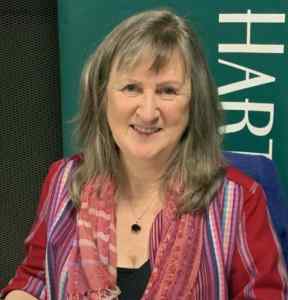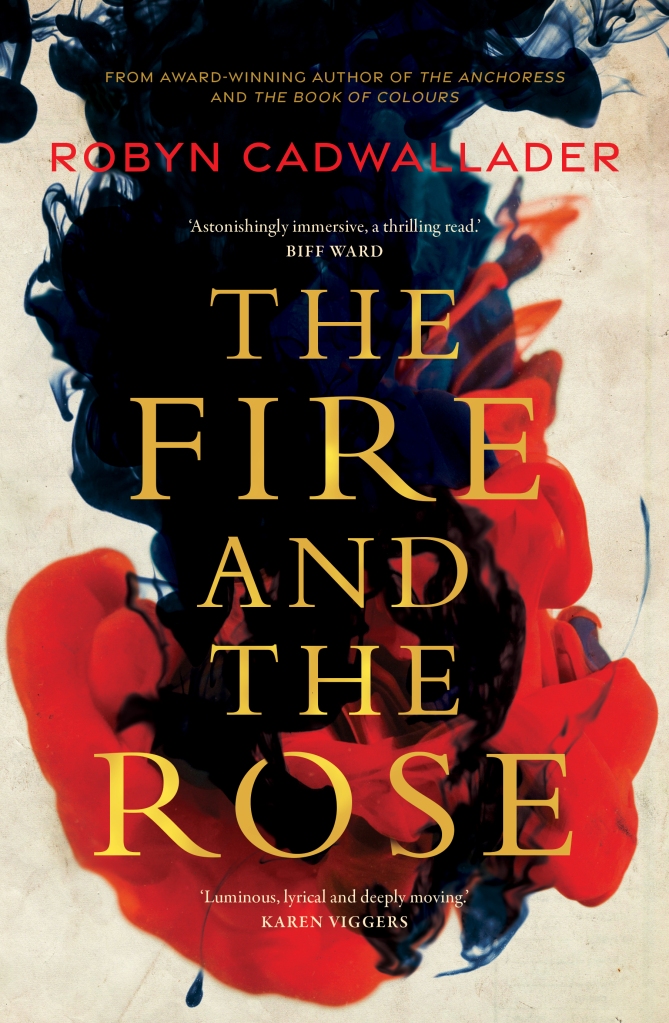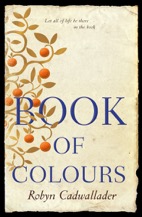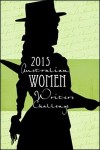I’ve been a great admirer of Robyn Cadwallader’s writing ever since her bestselling first novel, The Anchoress, was published in 2015. The Anchoress tells the story of a seventeen-year-old girl who chooses to renounce the world and become enclosed as a holy woman of prayer (my review here). Robyn’s second novel, Book of Colours, paints a vibrant, compelling portrait of medieval life and the lives behind the illuminated manuscript pages of that time (Robyn talks about Book of Colours here). Both novels were award winners and gained a huge following in Australia and beyond.
Robyn is a novelist and poet who lives in the country on Ngunnawal land outside Canberra. Prior to working as a researcher, academic and writer, she describes an eclectic early career: ’as a teenager, in retail, selling jewellery, women’s underwear and records (when they were popular the first time round); as a petrol station driveway attendant; and, during uni break, in the Kiwi factory, filling and packaging shoe polish, bleach and fragrant toilet blocks’. Sounds to me like a solid background for studying human life!
Robyn’s new novel, The Fire and the Rose, has been described as ’a heartbreakingly timeless tale, richly imagined and wondrously alive’ (Nigel Featherstone) and ’a beautifully written, thought-provoking exploration of prejudice towards minorities‘ (Canberra Times). I was thrilled to have the opportunity to ask her about it…
England, 1276: Forced to leave her home village, Eleanor moves to Lincoln to work as a housemaid. She’s prickly, independent and stubborn, her prospects blighted by a port-wine birthmark across her face. Unusually for a woman, she has fine skills with ink and quill, and harbours a secret ambition to work as a scribe, a profession closed to women.
Eleanor discovers that Lincoln is a dangerous place, divided by religious prejudice, the Jews frequently the focus of violence and forced to wear a yellow badge. Eleanor falls in love with Asher, a Jewish spicer, who shares her love of books and words, but their relationship is forbidden by law. When Eleanor is pulled into the dark depths of the church’s machinations against Jews and the king issues an edict expelling all Jews from England, Eleanor and Asher are faced with an impossible choice.
Vivid, rich, deep and sensual, The Fire and the Rose is a tender and moving novel about how language, words and books have the power to change and shape lives. Most powerfully, it is also a novel about what it is to be made ‘other’, to be exiled from home and family. But it is also a call to recognise how much we need the other, the one we do not understand, making it a strikingly resonant and powerfully hopeful novel for our times.
That moment…
AC: Robyn, where did The Fire and the Rose come from? What was the moment when you felt: This is a story I have to explore in fiction?
RC: While I was doing research for Book of Colours I came across a reference to the Jews being expelled from England in 1290. I read the sentence again; I was horrified. I’d never heard of this expulsion, so I read a little more. How could a group of people who were part of the fabric of a country be so summarily expelled? That question stayed with me, even when I dismissed the idea of writing a novel about it because it seemed too hard. Each of the three novels I’ve written has begun with an insistent question.
An intimate sense of the past
AC: You are well known for your re-creation of vivid, authentic worlds from a distant past—far more distant than I have ever attempted with my historical fiction. Has your background as a medieval scholar given you that strong sense of time and place, or do you use research methods that would be familiar to any writer of historical fiction?
RC: Both, I think. I consider research as a way of educating myself about a time and place, not simply gathering information to add into the story.
As an academic I studied medieval literature, and that necessarily involved understanding the history of the period. But the literature also gives a more intimate sense of the people: what they believed, what made them laugh, what gave their lives meaning, how they spoke about love or pain or desire. I think I soaked that in and became more familiar with people in the Middle Ages as a result.
When I begin a novel in a particular setting or period, I need to do more focused research. I read everything I can about the historical context, of course, but I’m also very interested in the material culture: physical location and topography, housing, food, etc. But I try to go a bit deeper still and ask myself the implications of whatever I learn. This might involve aspects that we take for granted; for example, I read and think about how people engaged with the senses; how they understood art, or beauty; how they understood their place in the world.
A novel of her own
AC: While your three novels do not form a series, there are crossovers from The Anchoress to Book of Colours and also to The Fire and the Rose. I think the protagonist of The Fire and the Rose, Eleanor, plays a role in all three, although she is only referred to in Book of Colours. What is it about this character that has had such a pull on your imagination?
RC: Oh, Eleanor was such a curious, clever and determined little girl that she refused to let her story end at The Anchoress; I think she wanted a whole novel of her own!
When I wrote The Anchoress I had no conscious sense of extending Eleanor’s story. In that story the anchoress wants to teach her to write, but because neither of them has access to parchment and ink, she shapes letters in Eleanor’s palm.
Even after the novel was finished, I thought about the implications for Eleanor of such a profound experience, discovering a whole world of words in such a sensual way, through the skin. I wondered how she would manage in a small village where so few people could read or write. Would the village become too limiting for her? Would she become restless? Would those around her resent her skills? Those questions were the seeds of her story in The Fire and the Rose.
Making sense of their world
AC: There are aspects of the human subject that are commonly considered universal, but people from the past did not necessarily think as we do today, and I imagine the further back in time we go, the more different those world-views would be. Is it a challenge to negotiate such differences when you create a character from the thirteenth century, or do they present an opportunity?
RC: I think the remarkable thing about investigating people from the past is just how similar they are to us, and at the same time, just how different they are. When I write, I try to hold those two ideas together.
Through the process of writing these three novels, I’ve slowly discovered that limitations or differences are a challenge, but often a good one that pushes me to take a story further. Of course, it means more research in order to understand the beliefs and thinking of the time. My primary interest in writing stories set in the Middle Ages is trying to understand how the people then made sense of the world they found themselves in, and I think that’s true of anything I write in a contemporary setting as well.
We do people from the past a great disservice if we simplify their thoughts and motivations and experiences. For example, when I began writing The Anchoress, the challenge was to write meaningfully about a woman who chooses to be enclosed in a stone cell for life, there to pray and read and ‘suffer with Christ’—something I would never do. As I grew to understand Sarah more closely, I recognised that my initial assumption that she was a very committed and holy woman was much too simplistic. Our motivations are never so simple. Once I began to consider Sarah as a full person, I could begin to explore the fears, desires and dreams that led her to choose enclosure.
Writing the other
AC: The brutal treatment of Jews by the English drives The Fire and the Rose, and in your Author’s Note you describe your position as a Gentile writer writing of this painful history as coming to the work ‘with a bowed head’ (after Colum McCann). More than once you have Jewish characters telling Eleanor, a Gentile, that her own experiences of marginalisation do not give her the right to think she understands theirs. Does this impossible gap between empathy and understanding reflect, in some way, the challenge for a novelist trying to write of the other?
RC: This is a very interesting and somewhat tricky area.
Even though Eleanor is, at times, rebuffed by Jewish people, I’m not suggesting that there is an impossible gap between empathy and understanding. I think Eleanor grows into a profound understanding of the situation of the Jews and their struggle, but I was exploring some of the implications of extreme prejudice.
In the novel, the Jews have been attacked again and again, forced to retreat, relying only on one another for support and comfort. The times that Eleanor is rebuffed are most often moments of grief and stress for the Jews, and their rejection of her attempts to understand their suffering is a product of their marginalisation and the attacks. When they are treated as ‘other’, the divisions are enforced, and in the emotion of the moment, Eleanor is on the other side. However, the relationship between Eleanor and Asher demonstrates how love—the commitment to another through hardship and struggle and delight—can overcome such divisions. The deep bond between Eleanor, Hannah and Marchota is another example.
I recognised that the profound impact of prejudice on Jews and their culture could have implications for my writing, and I spent some time debating and investigating whether I should write this novel, or not. I was warned by a First Nations Australian woman that I shouldn’t attempt to write about a group of people if I didn’t have ‘skin in the game’ because if I made mistakes in my portrayal, it is they, not me, who would suffer as a result. However, a Jewish woman commented in response that if I didn’t tell the story, others would never know it. I knew there was a risk of offending others, but I made several strong commitments: to research as deeply as possible, to seek help and opinions from Jews (I had three sensitivity readers, and another three Jewish readers), and to write only from the point of view of a Gentile character; I would not assume to write from the Jewish point of view.
I think that a writer always seeks to get inside the experience of another person, so in theory, it should be possible to write about others who have a very different experience and outlook from the writer. However, I don’t think that means a writer should just assume that they can write anything. There are areas of sensitivity and marginalisation that need to be carefully considered, but I am heartened by the Jewish woman’s encouragement to write the story so that others would learn of it.
An eternal witness in stone
AC: The walls of the city of Lincoln are given a voice in the novel. These poetic sections, headed ‘The Walls Speak’, provide a chorus of Lincoln’s history, the physical embodiment of its memory, and a brief, eloquent commentary on the timelessness of persecution. It occurred to me that the personification of the inanimate in this novel and also in Book of Colours (the gargoyle) might spring from the same intense experience I have felt during site research—feeling the past in brick and stone. Could you please talk about this aspect of the novel?
RC: Yes, you’re right. I have always loved stone, with its long, long formation in the depths of the earth, its endurance, and the huge range of ways we transform it: into protection, memorial, worship, beauty, foundation and so on. It’s everywhere in Old Lincoln: castle, cathedral, street paving, houses, walls. I knew that the stone would need to speak in some way. I imagined the city walls that completely surrounded the city in the Middle Ages would have stood guard, silent witnesses to all of life in Lincoln, from the joys and celebrations to the suffering, struggle and death. That would include the persecution of the Jews. It’s also ageless, and I found it easy to imagine it as an eternal witness. Even the Bible, in both Old and New Testaments, describes the stones or the walls crying out when people remain silent.
Finding a title
AC: I always find book titles interesting—I think because I’ve had the experience of being wholly certain of what a title should be, as well as the opposite. And when it comes to publication, settling on a title can sometimes be a battleground! Was The Fire and the Rose the first and only title of this novel?
RC: Oh, I’m no good at finding a title at all. I had several. The first one was ‘Not less than everything’, taken from T.S. Eliot’s line in ‘Little Gidding’: ‘A condition of complete simplicity / Costing not less than everything’, because I felt that Eleanor and Asher’s love would, in some ways, cost them everything. However, my agent and my publisher both said it was too vague to communicate well—though it’s interesting that there are quite a few novels now with titles that are phrases. We didn’t battle, because I trust their experience, but I struggled to find another title. My agent suggested The Fire and the Rose, and I discovered that it did suit the story.
Perhaps I’ll call on you for the title of my next novel, whatever it is! [Best not, I think!]
A life goes on
AC: Might we anticipate meeting Eleanor on the page again?
RC: Never say never, but I suspect not. She is someone I would love to meet; wherever her life goes, she will be fascinating and never dull.
The Fire and the Rose is published by Fourth Estate (Harper Collins)
Follow Robyn on Facebook or via her website
Read a review by Lisa (ANZ LitLovers)






